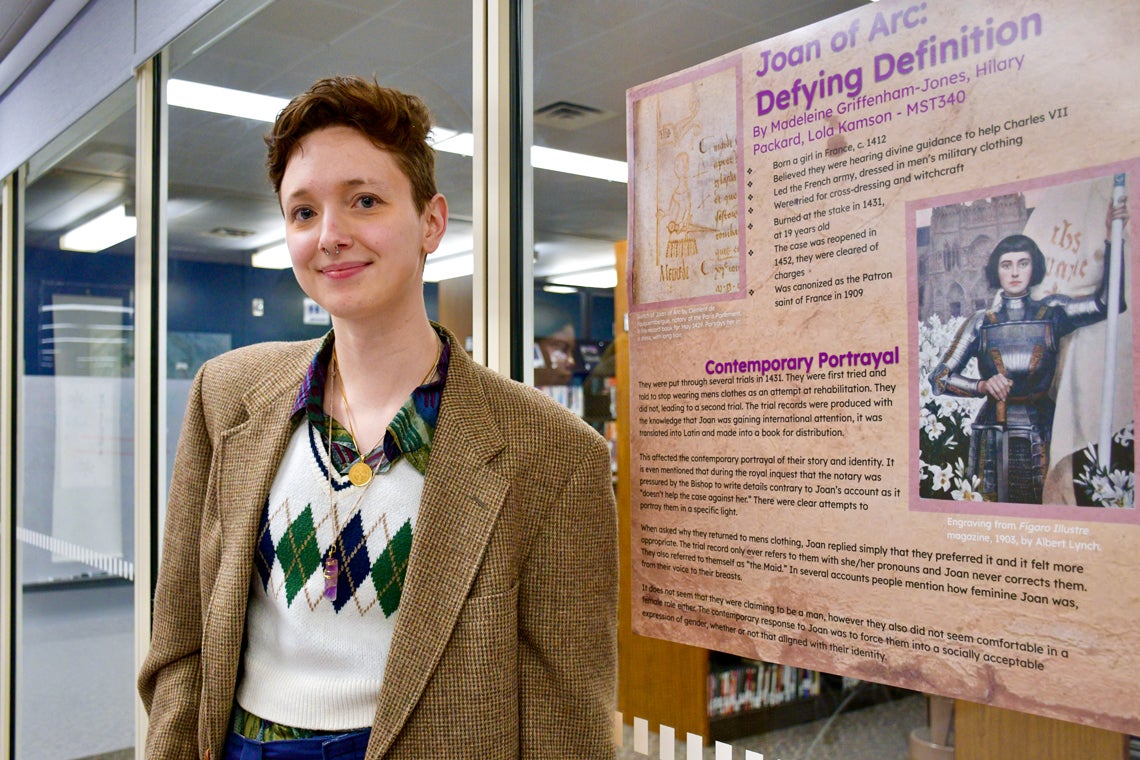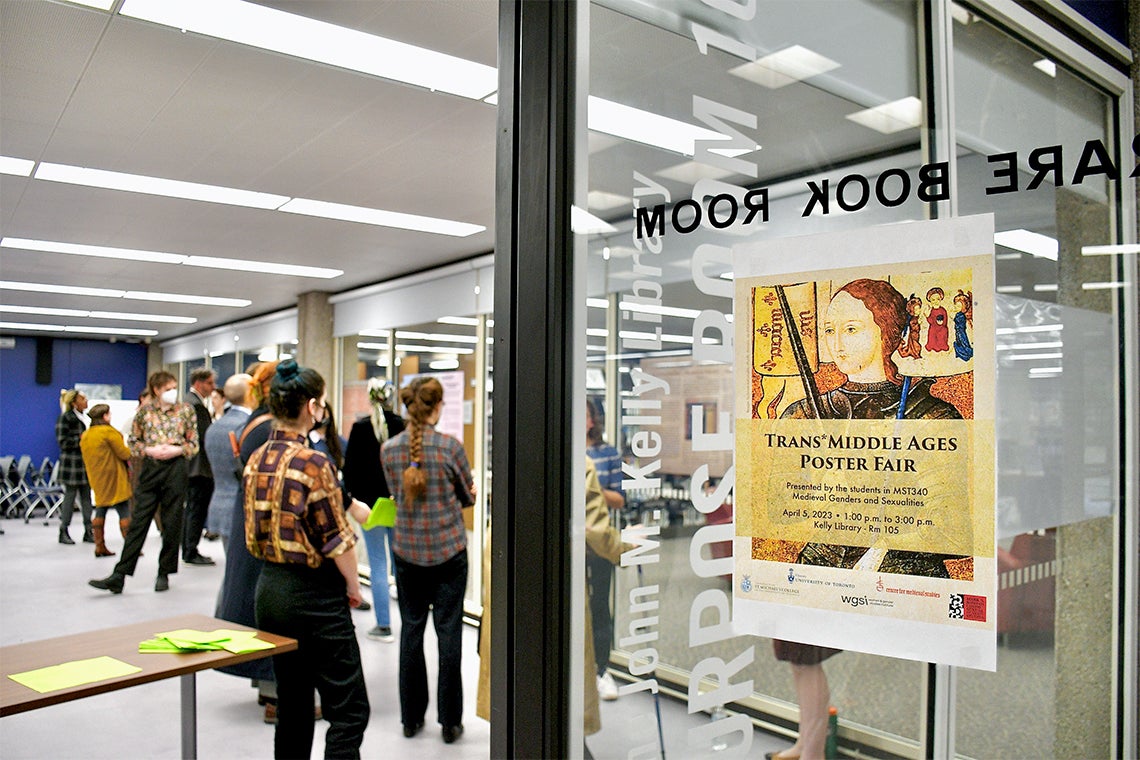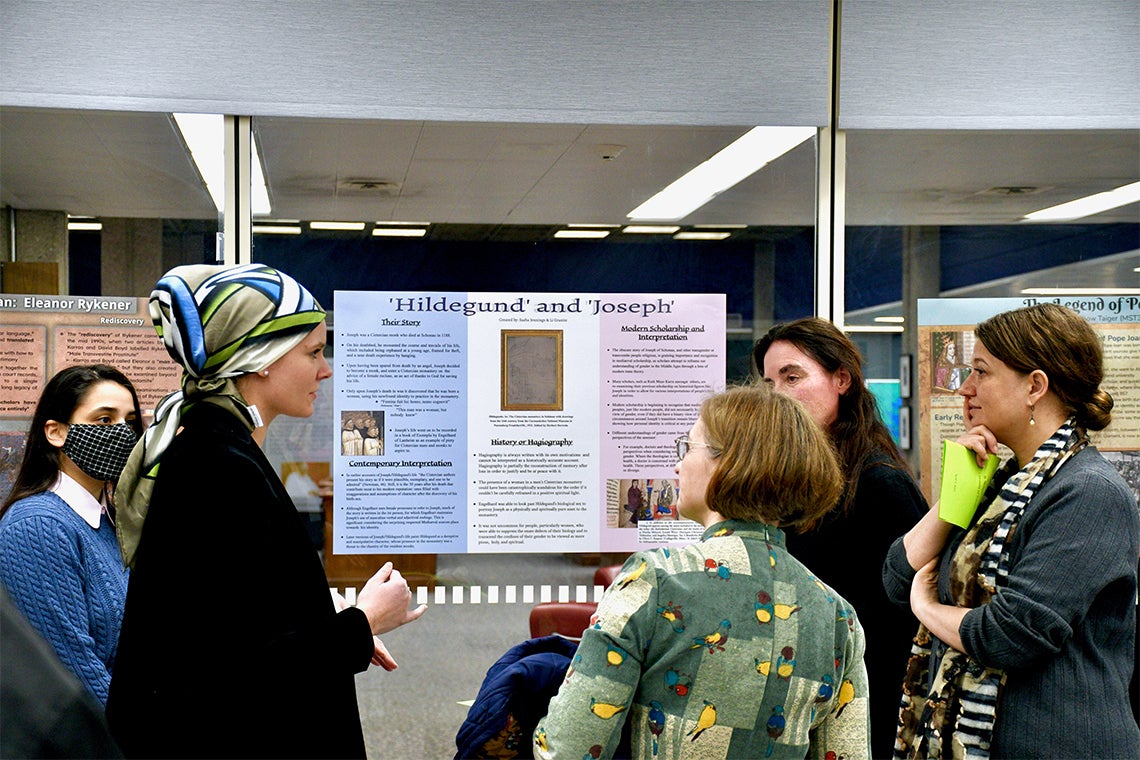Medieval studies students bring the diverse gender experiences of the past into the present

Medieval studies student Dena Abtahi researched the trial of Katherina Hetzeldorfer, who was executed in 1477 (photo by Diana Tyszko)
Published: June 1, 2023
Students from the University of Toronto’s department of medieval studies in the Faculty of Arts & Science recently presented an exhibit that highlighted the diverse gender experiences of people during the medieval period.
Students from the Medieval Genders and Sexualities course held a poster fair at St. Michael’s College that showcased specific historical figures (including many saints), offering evidence of people who lived outside of – or challenged – gender norms.
The exhibition capped the upper-year undergraduate course, which explores ideas about sexes, genders and sexualities in the medieval Christian West.

(photo by Diana Tyszko)
“Parts of our society tend to think that aspects of sexualities and genders that we see now are part of some social change that's gone on in the past decade,” Murray says. “These misunderstandings are fueling the harshness and the almost inhumane treatment that we see of trans people in some quarters of society, particularly in the United States.”
Twelve students working individually and in groups presented six posters covering important figures from the 5th to 15th centuries, highlighting how they have been understood and misunderstood throughout history.
Hilary Packard, a second-year visual studies student in the Daniels Faculty of Architecture, Landscape and Design who is also taking courses in medieval studies, was part of a trio that created a poster about Joan of Arc, a French saint who was burned at the stake for heresy.
“I loved the fact that I got to dive deeper into Joan’s story,” Packard says.
Scholars and artists have more recently begun to see Joan’s cross-dressing as more of a representation of masculine gender expression, as opposed to the more traditional view that she wore masculine clothing to appear sexless.
“I'm American and I’m trans, so being able to put this into the context of history and to say, ‘We've been here all along and we belong here’ is a very powerful thing because a lot of the arguments people are making are that people just started being trans in this century,” Packard says.
"I’m getting to see the historical re-evaluation that is currently happening, this new wave of understanding with people reflecting their own stories back on things – that's how history should work.”

Fourth-year student Dena Abtahi created a poster covering the trial of Katherina Hetzeldorfer, who is considered the first woman to be executed for homosexuality – a then-nameless crime – in 1477. Originally from Nuremberg, Hetzeldorfer moved to Speyer in 1475 and dressed as a man in the company of a woman, where they both lived together as a married couple.
“Katherina’s is one of the first historical accounts of trans people, which allows for people in our generations to look back and see that LGTBQ+ individuals have always been around,” says Abtahi, who is studying human biology and molecular biology.
“In this sense, Katherina is a symbol of the importance of self-expression and self-identification. “And in so many ways, Katherina's story highlighted how in some respects our society has remained stagnant on views pertaining to LGBTQ+ people and their rights.”
For Abtahi, researching a person being persecuted for simply being who they want to be struck a personal chord.
“People in Iran, where I am from, are being killed for being gay or being transgender,” she says. “And in Iran, when people do come out as homosexual, there are some instances where they are forced to undergo transgender surgery, as way of a correction.”

Sasha Jennings, a third-year student studying classics, medieval studies and Celtic studies, was part of a duo that created a poster about Hildegund, a German saint who was assigned female at birth but adopted the name Joseph and joined a Cistercian monastery as a man.
In fact, it was only after Joseph’s death in 1188, as his body was being prepared for burial, that his fellow monks discovered that their brother was in fact born female.
Joseph’s life went on to be recorded as an example of piety for Cistercian nuns and monks to aspire to – portraying Joseph as a physically and spiritually pure asset to the monastery.
“When it comes to religious identity, there's a really interesting relationship between gender fluidity and piety and sanctity,” Jennings says.
“There was an idea that if you could shed your biological limitations – especially if you were a biological woman – that put you on the path to religious piety and sanctity, and that was seen as a very good thing.”
Course instructor Jacqueline Murray, a graduate of U of T's Centre for Medieval Studies and a university professor emerita from the University of Guelph, says that in researching these ancient examples of gender fluidity, the students have come away with an understanding of what the stories of Hetzeldorfer, Hildegund, Joan of Arc and others mean in the modern context.
“Understanding trans issues and trans people has become so important in our society,” Murray says.
“We're trying to be part of this process of giving trans people their history, because there are – and have always been – many ways that individuals experience and live their identity.”



